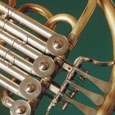Beginning horn students often find the instrument comes with a handful of difficulties to overcome. While the horn is not as un-wieldy as a tuba or double bass, poor posture and impaired breathing often result from trying to compensate for the size and awkwardness of the instrument.
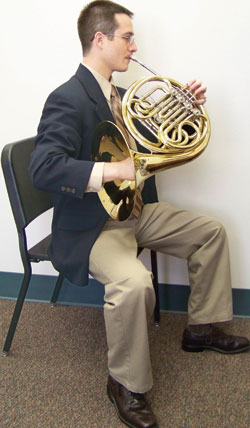 Playing Position and Posture
Playing Position and Posture
For a start it is important to raise the horn to the lips without bending to reach the mouthpiece. The sitting posture should be straight with the feet flat on the ground and positioned several inches away from the back of the chair. The angle of the leadpipe should match the structure of the student’s jaws and teeth. Many horn players have a slight overbite, producing a playing position with a descending leadpipe angle. The bell of the instrument should not face directly into the body, which would muffle the sound.
The playing position should feel comfortable, and for small students a three-quarters size horn may be best if one is available. These are actually a fully functioning instruments that have been scaled down and wrapped a bit differently than full-sized instruments to create a smaller, lighter horn. It may also help to add a holding strap or left-hand support to take some weight off the pinky finger.
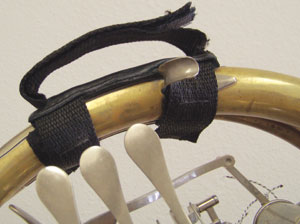
A horn support puts some of the weight on the right leg and help young students to hold the instrument at the proper angle with less strain to reach the mouthpiece.
Players with small hands may have trouble reaching the valve levers, but a simple adjustment to the height of the valve levers requires only a screwdriver. This entails loosening the stop arm screw, adjusting the valve lever to the desired height, and retightening the stop arm screw to keep the lever in the new place. To set all of the levers at the same height use the edge of a table to hold the levers in place while loosening and retightening the stop arm screws.
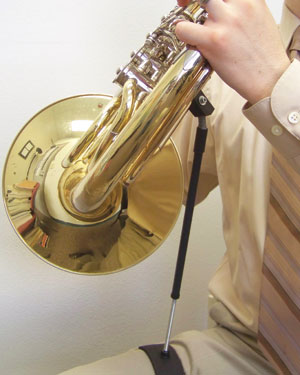
Clarinet thumb rests, dimes, or finger cups can be easily attached to the levers, allowing for a more comfortable grip.
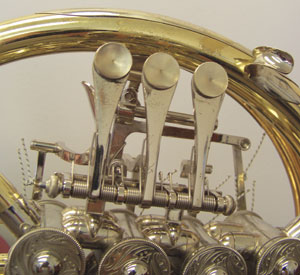
Breathing
The focus for beginning and intermediate-level students should be good breathing using general descriptions of the process instead of detailed explanations. Describe a balloon as it fills with air and expands naturally in all directions without being forced. When released it contracts naturally. Describe the sensation of air rushing across the tongue as water flowing over a waterfall. Thinking about round syllables while inhaling, such as hoh or hah, may help the throat and oral cavity remain open. The sensation of a relaxed, full breath is similar to that of yawning with an open mouth.
Many players, even advanced ones, tense up while breathing. It is crucial to remember that the diaphragm is an involuntary muscle, and that playing with good air support – freely and without tension – does not require a tight or tensed abdomen.
Embouchure
The embouchure should feel natural and not be the result of contortions to form it. Noted teacher and performer Philip Farkas described a good horn embouchure as a puckered smile, with neither too much lip in the mouthpiece (pucker) nor too little (smile). The embouchure should not have pockets of air behind the upper or lower lips or in the cheeks. Both lips should rest against the upper and lower teeth respectively, with no air behind. I find that asking students to say emm with the chin pointed toward the ground is an effective way to form an embouchure. Feel the lower teeth firmly behind the lower lip but avoid letting the area just below the lower lip bunch. Another approach is for students to free buzz without using a mouthpiece as an aid to form an embouchure. To produce a decent free buzz requires a correct embouchure. A lack of chin control will become obvious when a student attempts to free buzz; the chin and lower lip may bunch. It may help a free buzzing to place the index finger on the lower lip and chin, holding them in position while buzzing. This adds support until the muscles develop, and the need for the index finger will disappear. To initiate a free buzz, students can imagine spitting a seed or a hair off the end of the tongue.
Mouthpiece Placement
The age-old prescription of two-thirds upper lip and one-third lower lip really does work, although jaw and lip may affect mouthpiece placement. For students with thin or medium lips, lining up the bottom of the mouthpiece with the lower outside edge of the bottom lip can help in finding a correct embouchure placement. For players with thick lips, the bottom of the mouthpiece may not need to rest on the outside edge of the lower lip, but somewhere above it. It is important for the angle of the mouthpiece to follow the natural contour of the face. Because many people have at least a slight overbite, this results in a descending angle. Players with even bites or under bites should have straight or slightly ascending mouthpiece angles. Moist lips help the mouthpiece to settle into the sweet spot, as well as keeping the embou-chure from sticking during lip slurs or wide leaps. Many young players use an embouchure with too little top lip in the mouthpiece, which makes higher pitches and a characteristic tone difficult to produce.
To find the proper proportion of upper to lower lip, think of the lower lip as an anchor point for the mouthpiece, while the upper lip acts as a hook for the upper two-thirds or so of the mouthpiece. Consistent practice with a mirror on the stand is important until the embouchure muscles become accustomed to a regular mouthpiece position. A good test of mouthpiece placement is being able to produce a fairly loud, healthy-sounding buzz. A good buzz on the mouthpiece sounds free and open, rather than tight and constricted.
Right Hand Position
Many young horn players play with their hands too far into the bell or use an overly covered hand position. The ideal right-hand position has a slight bend at the knuckles but is fairly straight from the knuckles to the finger tips. with the thumb touching the index finger and no spaces between fingers. The palm is slightly cupped, as if swimming freestyle or holding shampoo.
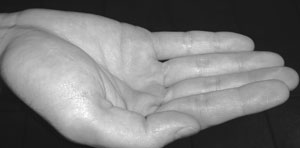
When placing the hand in the instrument, press the right hand against the far right side of the bell and allow it to conform to the shape and size of the bell, which will result in a slightly rounded shape. Line up the knuckle of the thumb with the bell brace, then insert the right hand so the thumb touches the upper part of the bell and the bottom edge of the hand contacts the bell.
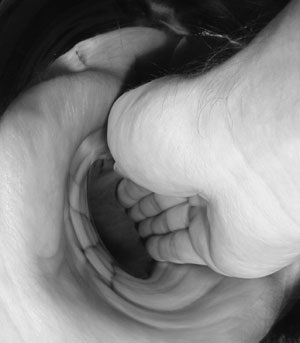
Avoid curling the fingers inside the bell or splaying them out. Keeping the right elbow well away from the side of the body helps maintain an open hand position that will not muffle or otherwise obstruct the sound.
Braces
Possible complications from braces include playing discomfort, loss of range and endurance, lack of dynamic contrast, unfocused sound, frustration, and discouragement. Teachers should stress to students that these effects are not permanent, and that with patience and persistence it is still possible to play well while wearing braces. Players with braces should remain focused on producing a characteristic sound in the middle range. It is important to avoid excessive mouthpiece pressure as an aid to producing higher pitches. Instead, work towards a relaxed and open aperture in the middle register. Exercises such as long tones at a comfortable dynamic range; slow, slurred scales in the middle register; and daily mouthpiece buzzing can help rebuild range, endurance, and self confidence. Brace guards can be used to relieve playing discomfort, but wax should be avoided, as it may get blown into the horn. One of the best tools for dealing with braces is a mouthpiece with a wide, flat rim, which will more evenly distribute pressure and allow greater playing comfort.
